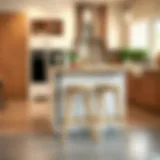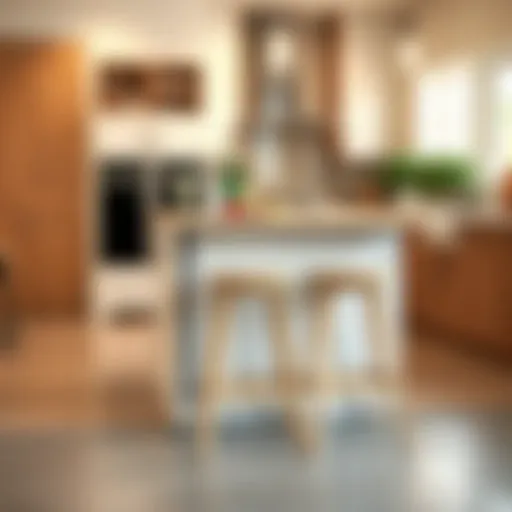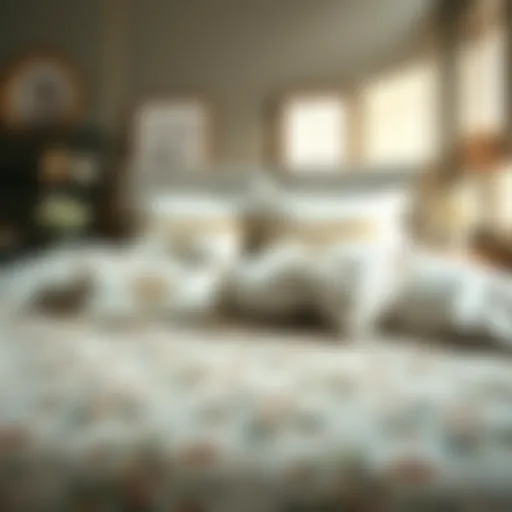Exploring the Versatility of Free Standing Boards


Intro
Free standing boards are increasingly becoming essential elements in both homes and professional environments. Their dynamic nature allows for a plethora of applications. From enhancing workspace organization to serving as creative canvases for personal expression, these boards richly contribute to diverse settings. Understanding their versatility can inspire homeowners, designers, and DIY enthusiasts alike. Let’s unpack how these boards, often overlooked, hold the potential to transform spaces both functionally and aesthetically.
Furniture Trends
Current Market Trends
In recent times, there's a noticeable shift towards customizable and multifunctional furniture. Free standing boards fit snugly into this trend. Many modern options boast materials that are eco-friendly and designs that cater to various tastes. As more individuals opt for minimalist decor, these boards serve both practical and stylistic needs—totally adaptable and easily movable.
- Eco-friendly materials: Bamboo, recycled plastics, and sustainably sourced woods are leading choices. They not only contribute to environmental conservation but also bring warmth to spaces.
- Multifunctionality: Today’s boards often serve dual purposes, such as whiteboards that can also be used as art displays, or boards that function both as partitions and pin-up boards.
Popular Styles and Designs
When it comes to styles, the industry is brimming with options. Various design aesthetics cater to different preferences and needs. Some noteworthy trends include:
- Scandinavian Minimalism: Clean lines and understated colors characterize this style. Boards in neutral tones blend seamlessly with any decor.
- Industrial Chic: Utilitarian designs and raw materials dominate this style. Think reclaimed wood paired with metal accents for a striking yet functional statement.
Choosing a design that resonates with the overall aesthetic of the space is paramount. Men and women alike can find designs that speak to their personal taste while also serving significant functions.
DIY Projects
Step-by-Step Guides
For the crafty individual, customizing a free standing board is a rewarding project. Here’s a simple guide:
- Gather Materials: Start with a plain board, paint (chalkboard or whiteboard paint), and any decorative elements you like—think washi tape or stencils.
- Prep the Surface: Make sure the board is smooth and clean. Sanding it lightly can help paint adhere better.
- Apply Paint: A couple of coats of paint usually do the trick. Allow ample drying time between coats.
- Add Accessories: After the paint dries, consider adding hooks, clips, or even magnets for additional functionality.
- Showcase Your Board: Hang it in a prominent place. You’ve not just made a board; you’ve created a focal point!
Budget-Friendly Ideas
If you’re on a shoestring budget, worry not. Transforming free standing boards can also be cost-effective:
- Repurpose Old Boards: Revamp an old board with a fresh coat of paint or a new frame.
- Thrift Store Finds: Keep an eye out for unique boards at local thrift shops. A little cleaning and sprucing can result in a one-of-a-kind piece.
Moreover, integrating these boards into your space doesn’t have to break the bank. With creativity and smart sourcing, homeowners can achieve elegance and utility without overspending.
"Free standing boards empower creativity and collaboration, making them an invaluable asset in any environment."
With the right insights and hands-on approaches, individuals can delve into the world of free standing boards and explore their limitless opportunities.
Prolusion to Free Standing Boards
Free standing boards occupy a unique niche in both functional and creative realms. Their importance transcends mere utility, offering diverse applications that cater to various audiences, from homeowners to professional event planners. Understanding what these boards can bring to the table is essential for anyone seeking to enhance their spaces, whether at home, in class, or at work.
Defining Free Standing Boards
Free standing boards are versatile, movable surfaces that are not fixed to walls or any other permanent structures. Unlike traditional boards, their portability allows them to adapt to any environment. These boards can be divided into several categories, including whiteboards, chalkboards, display boards, and room dividers. Each serves distinct purposes, catering to specific needs while promoting creativity and interactivity.
- Whiteboards: Ideal for brainstorming sessions or teaching moments, they allow for easy writing and erasing.
- Chalkboards: Often associated with educational settings, their rustic charm has made them popular in homes and cafes as well.
- Display boards: These are essential for showcasing picture, information, or advertisements, particularly at events or in retail spaces.
- Room dividers: More than just aesthetic separators, they help in managing space and enhancing privacy.
Historical Context and Evolution
The story of free standing boards is quite fascinating. Their origins can be traced back to the earliest forms of teaching, where flat stones or wooden surfaces served to convey ideas visually. With time, as educational methods evolved, so did the boards themselves.
In the 19th century, chalkboards made their debut in classrooms, transforming the teaching landscape. They provided a more dynamic way to impart knowledge compared to the static textbooks of the day. In the mid-20th century, the introduction of whiteboards revolutionized not only education but also the business environment.
The evolution didn’t stop there. As technology advanced, we now see a rise in smart boards integrating digital functionality with traditional uses. The concept has continued to adapt, reflecting changes in needs and preferences in a society that values agility and aesthetic appeal.
Free standing boards today are not just functional tools; they embody creativity, practicality, and versatility, making them essential in modern design and utility.
Types of Free Standing Boards
Understanding the various types of free standing boards allows homeowners, renters, and design aficionados to select the right kind for their needs. Each type serves unique purposes, and knowing the advantages of each can significantly enhance any given space. From fostering collaboration in offices to providing aesthetic value in living rooms, free standing boards are versatile tools worth considering. Let's delve into the specifics of these categories to appreciate their distinct roles.


Whiteboards and Chalkboards
Whiteboards and chalkboards represent the classic duo in the educational and professional realms. Whiteboards are typically made from materials like melamine, glass, or porcelain, offering a sleek surface for dry-erase markers. Their clean, modern appearance aligns well with contemporary designs, making them suitable for home offices, classrooms, or brainstorming sessions in corporate settings.
Here are some benefits of whiteboards:
- Easy to clean compared to chalkboards.
- Available in various sizes, from small portable boards to large wall-mounted versions.
- Magnets can be used on magnetic boards, allowing attachment of notes or images.
On the other hand, chalkboards evoke nostalgia, harking back to the days of classrooms and learning. They feature a textured surface designed for chalk, which, while less visually appealing, offers a tactile element that many find satisfying.
The use of chalk allows for easy erasure, though some maintenance is involved to avoid dust accumulation. Chalkboards are often favored for their lower cost and can be a more affordable option for informal settings like home kitchens or children’s playrooms.
Display Boards
Display boards take the spotlight when it comes to showcasing information visually. Organizations, schools, and marketers often utilize them to present posters, photographs, or important announcements. The board can be designed with cork or fabric surfaces to allow easy pinning and re-arranging of materials.
The significance of display boards lies in their ability to engage viewers through color and design, making essential content more approachable. Consider these points about display boards:
- They encourage creativity by allowing customizable presentations.
- Can be utilized in various settings, from classrooms to exhibitions.
- They make information accessible to a larger audience, transforming what might be a monologue into a dialogue.
Room Dividers
Room dividers have gained popularity as a practical yet stylish way to redefine spaces without the need for permanent construction. Whether it’s an open concept loft or an office environment, these boards can segregate areas temporarily or permanently, ensuring privacy where necessary.
Features of room dividers include:
- Mobility – many models are portable, allowing you to change the layout at will.
- Various materials and designs, from textiles to wooden panels, can match your decor style.
- They provide an easy way to hide clutter or create intimate corners in larger spaces.
Using aesthetically pleasing dividers can also enhance the overall ambiance, adding character while promoting functional zoning.
Multifunctional Boards
The multifunctional boards stand proud as the Swiss Army knife of free standing boards. This category includes boards that serve a dual purpose or more, often combining writing surfaces with features like storage or visual display options.
For instance, a board could have a magnetic whiteboard surface on one side and a cork board on the other. The flexibility of multifunctional boards is impressive:
- Space-saving design appeals to those in compact living spaces.
- Ideal for shared spaces where different activities occur simultaneously.
- Encourages multi-dimensional thinking by adapting to various needs, from project planning to showcasing artwork.
The growing popularity of multifunctional boards reflects a shifting focus toward efficient use of materials and maximizing functionality in design.
By exploring these types of free standing boards, users can make informed decisions that align with their needs for style, functionality, and adaptability. Whether aiming for a pedagogical tool, a creative display, or a means to separate spaces, each type has a vital role to play.
Choosing the Right Free Standing Board
Choosing the right free standing board can significantly impact its functionality and how effectively it serves its purpose. It's like selecting a tailor-made suit; you need to consider various aspects from material and size to how well it complements your existing decor. A well-chosen board not only fits the practical requirements but can also enhance the overall aesthetic of a space. The goal here is to provide insightful guidance on making that choice, ensuring you make a decision that aligns with both your needs and preferences.
Considerations for Material Selection
When selecting a free standing board, the material it’s made from plays a crucial role in determining its suitability and durability. Each material comes with its own set of characteristics that can influence both functionality and appearance.
Wood
Wood has a timeless appeal. Its natural look brings warmth to any environment, whether in a casual home office or a more formal setting. The key characteristic of wood is its versatility; it can be crafted into different finishes, allowing for customization in both color and texture. Additionally, wood is known for its durability. A well-treated wooden board can last for years if properly maintained.
However, wood does have some challenges. It can be prone to scratches, and without the right protective coatings, it may suffer from water damage. So, while the unique visual appeal of wood can be a strong draw, potential buyers should weigh these disadvantages against their needs.
Metal
Metal stands out for its robustness and modern aesthetic. The key characteristic of metal boards is their strength; they can withstand heavy use without showing signs of wear. This makes them particularly appealing for busy settings like schools or conference rooms. Furthermore, metal can be easily cleaned, eliminating concerns about stains or damage from liquids, which is a practical advantage.
The downside? Metal can often feel cold or harsh in a homey environment. In some instances, it may not blend well with softer decor elements found in more relaxed spaces. The challenge here is to strike a balance between functionality and comfort when considering metal boards.
Plastic
Plastic boards often find a place in settings that prioritize portability and adaptability. Their lightweight nature allows for easy rearranging, which is perfect for dynamic environments like workshops or classroom settings. A significant benefit of plastic is its resistance to moisture and durability against fading or breaking, making it an ideal choice for both indoor and outdoor use.


However, plastic boards can lack the aesthetic appeal that wood or metal offers. In more refined or decorative spaces, a too-casual plastic appearance can feel out of place. It’s important to evaluate whether the unique features of plastic will meet the spirit of the space you are aiming for.
Size and Placement Guidelines
Size matters when it comes to selecting free standing boards. A board that is too large can overwhelm a small room, while one that is too small might not serve its purpose effectively. An effective size strategy should consider the available space and the intended use. For instance, a large whiteboard in a corporate office can facilitate better team collaboration, but a confined home study might benefit from a more modestly sized slate. Additionally, consider the board's placement; it shouldn't obstruct pathways but should remain easily accessible for writing or viewing.
Aesthetic Compatibility with Interior Design
The aesthetic aspect is often where free standing boards become game changers in a room's design. A board that matches or complements the interior decor can enhance visual harmony. Think about color coordination, material contrast, or even texture variations. Does your living space lean towards modern minimalism? Consider sleek metal options in muted tones. If your decor showcases warm, rustic elements, then a wood board would fit right in. The right choice will not only serve a functional need but elevate the space’s decor as well.
Functional Uses Across Different Environments
Free standing boards offer remarkable versatility, adapting to a variety of environments and needs. They can serve as communication tools, creative canvases, or solutions for spatial organization, all depending on where they are placed. Their importance lies in the ability to transform a space, turning it from ordinary to functional. From optimizing home office setups to enhancing educational experiences, these boards hold significance in daily life and professional settings.
Home Offices
In the evolving landscape of remote work, home offices have become essential. Free standing boards can play a crucial role here. They can be used as places to jot down ideas, keep to-do lists, or simply brainstorm thoughts. Picture a sleek whiteboard standing tall in your office, displaying key project timelines or goals. This not only keeps you organized but also makes your home office feel more vibrant.
Moreover, a pinboard can showcase inspiration—photos, quotes, or critical documents that keep you motivated. These boards help define your workspace, not only physically organizing it but also mentally reinforcing your work focus. When choosing the right board, consider size and placement; you want it to be readily visible yet not intrusive. A well-placed board can elevate productivity while adding a touch of creativity to your daily grind.
Educational Settings
In educational environments, the role of free standing boards cannot be overstated. They facilitate interactive learning, encouraging students to engage with the material actively. Whether in a classroom or a tutoring center, these boards encourage participation and collaboration.
- Whiteboards: Frequently used for lessons, allowing teachers to write out math problems or outline complex theories. Their erasable surface invites corrections and dynamic teaching methods.
- Display boards: These can be used to highlight students' projects, making learning a shared experience.
With the rise of hybrid learning formats, free standing boards can also serve as a bridge. They facilitate group work while allowing for individual contributions in a shared classroom space, bringing both on-site and remote learners together in a cohesive way.
Event Spaces and Exhibitions
Event spaces and exhibitions are also ripe for the integration of free standing boards. They act as critical communication tools, providing information to attendees. At conferences, they can showcase schedules or speaker details prominently. Their versatility allows for customization—brands can have their logos displayed prominently.
Additionally, in trade shows, these boards can serve multiple purposes—presentation areas may morph into display sections, allowing participants to share information about their products interactively. More importantly, they offer a platform for dialogue; workshop leaders can jot down audience questions or main points, fostering engagement.
Therapeutic and Recreational Uses
Free standing boards also find a unique niche in therapeutic and recreational environments. In community centers or therapy offices, they provide a space for expression. Art therapy sessions utilize drawing boards where individuals can share feelings visually, promoting healing through creativity.
Similarly, in recreational settings like family game nights or workshops, these boards can support games or collaborative projects, fostering an enjoyable and connected atmosphere among participants.
- Feedback boards: They can allow visitors to express their thoughts physically, helping facilitators understand user experience and improve their offerings.
- Mindfulness boards: Used to encourage positive thoughts or goals can serve as a motivational tool for participants.
In summary, free standing boards transcend their basic purposes, serving unique functions across various settings. Adjusting the type and design chosen can significantly enhance user engagement and satisfaction in any environment. They transform spaces not only into more organized settings but also into places brimming with creativity and interaction.
Maintenance and Care
Maintaining free standing boards is crucial for both their functionality and aesthetic appeal. Regular care ensures longevity and enhances their usability across various environments. Whether you’re using a whiteboard in a home office, a display board in an exhibition, or a room divider in a busy space, keeping these surfaces clean and well-maintained helps maintain their effectiveness and presents a professional appearance.
Benefits of Proper Maintenance
The importance of establishing a solid maintenance routine cannot be overstated. Not only does it preserve the board's appearance, but it also prolongs its lifespan. Some key benefits include:
- Enhanced Longevity: Regular cleaning reduces the buildup of dust and grime, which can wear down the surface over time.
- Optimized Functionality: A clean board allows for clearer visibility of written or displayed information, making presentations more effective.
- Cost-Effectiveness: Investing time in maintenance can save money in the long run by preventing the need for premature replacements.
Cleaning Techniques for Various Surfaces
Cleaning free standing boards requires different approaches based on their materials. Here are some effective techniques for common surfaces:
Whiteboards
Whiteboards can be marred by ghosting or staining from dry erase markers. For optimal results:
- Use a dry erase board cleaner or isopropyl alcohol to remove ink residues.
- Microfiber cloths work wonders; they won’t scratch the surface and provide good absorption.
Chalkboards


Chalkboards may accumulate chalk dust that can create a mess. To clean them, try:
- A damp sponge or cloth to wipe off excess chalk.
- A chalkboard cleaner for deep cleansing, giving it a fresh surface for writing.
Display Boards
For display boards, such as cork or fabric:
- Gently vacuum with a soft brush attachment to remove dust and debris.
- Spot clean stains with a damp cloth and mild detergent.
Room Dividers
Cleaning room dividers, especially those made of fabric or wood:
- For fabric: use a lint roller or fabric brush to lift off dust.
- For wooden boards: lightly dust and occasionally polish with furniture polish for sheen.
Preventive Measures for Longevity
Ensuring that your free standing boards stand the test of time involves a mix of good habits and preventive care. Here’s how:
- Avoid Direct Sunlight: Position boards away from direct sunlight to prevent fading and warping of materials.
- Use Quality Markers & Erasers: Low-quality markers can stain surfaces or leave residues. Stick to high-quality options to lessen maintenance needs.
- Establish a Cleaning Routine: Just like any other tool, free standing boards benefit from regular scheduled maintenance—weekly checks can go a long way.
- Store Properly: If the boards are movable, be mindful of how they are stored when not in use. Avoid stacking them, which can cause scratches.
Innovative Trends in Free Standing Board Design
The design of free standing boards has dramatically evolved in recent years, reflecting a shift towards more sustainable and technologically integrated solutions. This section explores the notable trends that not only enhance functionality but also address contemporary consumer concerns regarding environmental impact, personalization, and the fusion of technology with traditional uses.
Eco-Friendly Materials and Practices
With a growing awareness surrounding ecological issues, the demand for eco-friendly materials in the production of free standing boards has surged. Manufacturers are increasingly opting for recycled materials, sustainable wood sources, and non-toxic finishes. These choices not only reduce the environmental footprint but also cater to the health-conscious consumers who are looking for safe options for their living and working spaces.
For instance, bamboo has emerged as a popular material due to its rapid growth and sustainability. Using bamboo for a whiteboard or room divider not only supports environmental responsibility but also adds a warm, natural aesthetic to any space.
Practices such as using low-VOC (volatile organic compounds) paints and dyes further enhance the appeal of these products. Homeowners and renters increasingly appreciate boards that don’t compromise indoor air quality. By adopting eco-friendly practices, manufacturers communicate their commitment not only to quality but also to the future of our planet.
Smart Technology Integration
As digital technology continues to permeate every facet of our lives, free standing boards are also embracing this trend. Smart boards now come equipped with features that allow for seamless integration with devices such as tablets and smartphones. This integration can enable writing, drawing, and annotating directly onto the board while simultaneously displaying related content from other devices.
Imagine a scenario at a design workshop where participants can jot down concepts on a smart whiteboard that is remotely accessible. Clients could view and comment in real-time, thus enhancing collaboration no matter where people are located. Brands like Samsung and Microsoft have already ventured into this space, offering boards loaded with collaborative tools and interactive displays.
These boards not only support traditional writing but also facilitate a more dynamic, interactive learning or working environment. The smart technology integration elevates the typical free standing board into a multifunctional tool that adapts to modern needs.
Customization and Personalization Options
Consumers today seek products that reflect their unique styles and needs, and free standing boards are no exception. Many manufacturers are stepping up by offering extensive customization options that allow buyers to specify size, shape, color, and surface type. This capability appeals to a wide audience from schools to corporate environments.
For example, a school might opt for a vibrant-colored display board that allows students to put their creative flair at the forefront of learning. Meanwhile, an upscale office might choose sleek, minimalistic designs that align seamlessly with its sophisticated decor.
Furthermore, some brands provide the option for engraved designs or printed logos, making these boards not only functional but also a branding tool for businesses.
By offering customization and personalization, manufacturers forge a stronger connection with consumers, ensuring the products not only serve a purpose but also resonate on a personal level.
Ending and Future Outlook
In this fast-paced world, the significance of free standing boards can’t be overstated. They have become more than just basic tools; they are vital elements that add value to various environments, from homes to offices and classrooms. The adaptability they offer is astounding, allowing users to engage in a multitude of functionalities, including presentation, division of space, and interactive learning. This article has examined their myriad benefits, key uses, and maintenance tips, all underscoring how they shape our everyday interactions.
Recap of Key Insights
As we've explored throughout this piece, free standing boards come in diverse types, such as whiteboards, display boards, and room dividers. Here are some key takeaways:
- Versatility: These boards serve multiple locations and contexts, thus catering to different audiences including educators, business professionals, and creative individuals.
- Material Matters: The selection of materials—ranging from wood and metal to various polymers—determines not just aesthetics but functionality and longevity as well.
- Easy Maintenance: Proper cleaning techniques and preventive care can extend the life of these boards, ensuring they remain functional and visually appealing.
- Innovative Trends: We've seen a shift towards eco-friendly materials and smart technology integration, which reflects a growing consciousness toward sustainability and efficiency.
"The right free standing board can transform a space and elevate its usage, making it not just functional, but a pivotal part of the environment."
Anticipating Future Developments
Moving forward, it’s essential to anticipate how free standing boards will continue evolving. The trends we see today hint at several promising directions:
- Integration of Technology: With the rise of digital tools, we can expect boards to incorporate more smart features, like built-in screens or connectivity with other devices to enhance usability.
- Sustainability Focus: As people become more conscious about the environment, the demand for boards made from recycled and sustainable materials could surge. Brands may even find new ways to create boards that leave a smaller carbon footprint throughout their life cycle.
- Custom Designs: The personalization of free standing boards is likely to amplify. Consumers will want options that not only fit their functional needs but also reflect their individual tastes and brand identities.
This dynamic landscape makes it clear that free standing boards are here to stay and will adapt to changing needs in the foreseeable future. For homeowners, designers, and all those in between, keeping an eye on these trends will enrich their experience in selecting and utilizing these indispensable boards.















